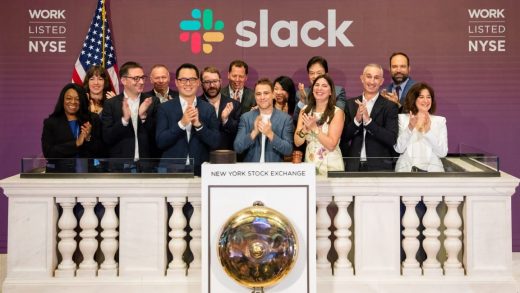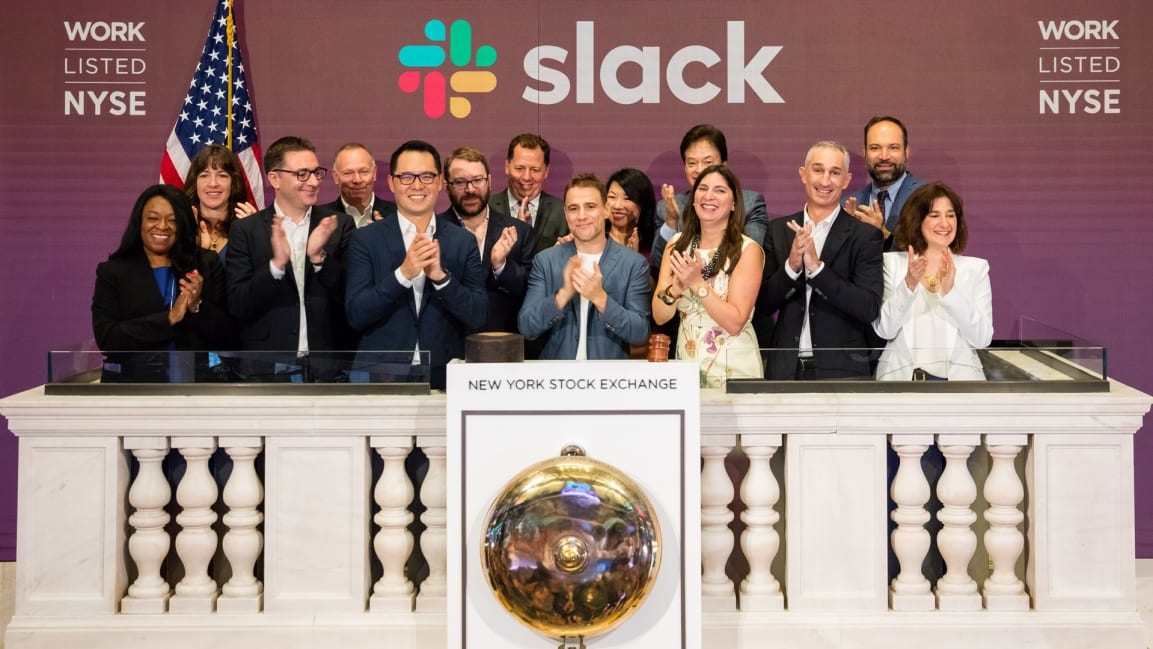NYSE floor dispatch: Slack’s non-IPO is off to an impressive start
Slack Technologies touts itself as a work productivity tool, and today it listed on the New York Stock Exchange with the ticker symbol WORK and a starting share price of $38.50.
Slack execs gathered at the NYSE for the opening bell, soaking up applause and posing for selfies on the company’s big day of commencing public trading. Slack banners, printed and digital, filled the walls and TV screens of the trading floor, providing the backdrop for the celebratory mood set by the Slack team, who perched high on the iconic balcony behind the bell. Onlooking traders cheered as if they were the management’s hype men and women. Floor regulars described the scene as busier than usual, but considerably less chaotic than that of the Uber IPO last month.
Participants stood through two-and-a-half hours of price discovery, a balancing act whereby supply and demand dictates the initial trading price of the stock. The market maker for Slack, Citadel Securities, which assumed the role of the central point of sale and provider of liquidity, was responsible for aggregating all the buy and sell orders. The price range slimmed from a wider $30 to $34 per share at 10:30 a.m. to a narrower $37 to $38 over an hour later.
Once the discovery process had played out and the price range was tight enough, the opening price was set at $38.50, higher than the reference price of $26 set Wednesday evening. The market makers made way for the first trades of Slack stock.
Rishi Jaluria, a capital market analyst at D.A. Davidson & Co., who is covering Slack, had expected the stock would trade up from the reference price but admitted Thursday afternoon that it went beyond his expectations. “I’m not surprised, but if I’m Slack, I’m really happy,” he said.
The software company took the uncommon route of a direct listing, rather than the tried-and-tested initial public offering, or IPO. It followed the “Spotify Rule,” coined for the music streaming service’s pioneering decision to launch publicly via a direct listing in April 2018.
The direct listing path cuts out the intermediaries, meaning Slack saves money on underwriter fees. And it saves time, eliminating the need for a road show, which many view as unnecessary for a fairly well-known brand such as Slack.
The direct listing also does not create new shares, as would an IPO, meaning shares can initially only be bought from current investors. It’s a way for early investors and employees to earn some liquidity.
One concern was that shareholders may jump to sell their stock immediately and cause volatility, because there’s no 180-day lockup period during which trading cannot take place.
“That’s why it’s so important to have a robust price discovering process and good communication between the market maker and the financial adviser,” said John Tuttle, vice chairman of the NYSE.
Volatility is a valid concern, said Citadel Securities’ Joe Mecane, the designated market maker, but all signs in the first few minutes of trading suggested that this was a positive debut. Out of 200 million eligible shares, over 40 million shares became available for sale, a good indicator of smooth sailing. To be sure, it’s wise to keep a heightened eye on the stock for a week or two to quell all fears of volatility.
The Future of ‘WORK’
Jaluria said Wednesday his recommendation for potential buyers was neutral, based on his view that the valuation, at $16 billion to $17 billion, was a tad rich, and that the company needs to branch out to show adoption by non-tech companies before he’s more certain of a smooth future.
“It tends to be almost entirely tech or companies that are trying to become tech companies,” he said. “That’s their bread and butter right now.” Slack’s website notes that companies such as Airbnb and Pandora use the service. Jaluria said he wants to see meaningful adoption in other fields like finance, legal, and healthcare. (Fast Company uses the service, as do many media outlets.)
The worry is the strength of competitors such as Microsoft and Google, names that Slack CEO Stewart Butterfield mentioned himself. Microsoft is developing its rival package, Microsoft Teams, which could pose a threat to Slack because so many companies worldwide already use Microsoft Office packages. “I think the biggest threat that Microsoft has down the line is to be good enough,” Jaluria said. If Teams is 80% as good as Slack, Jaluria said, companies are likely to run with the free software rather than paying for Slack.
The key, said Michael Facemire, a principal analyst at market research company Forrester, is that Slack, which in January boasted 10 million daily active users, stands out from the crowd with its features. It should continue to appeal to the consumer crowd with emoji and fun app integrations like Giphy, while also attracting the non-tech skeptics by allowing for integration of file-sharing tools and document storage that will likely be Microsoft’s focus.
Still, Jaluria was confident with Slack’s pricing model, because it ensures recurring revenue. Although first-time users can “Slack” for free, they have to transition into a paid membership after 10,000 messages and five app integrations.
“In the event of economic slowdown, or a downturn, I think subscription software holds up very well,” he said.
This story was filed via Slack.
(32)



